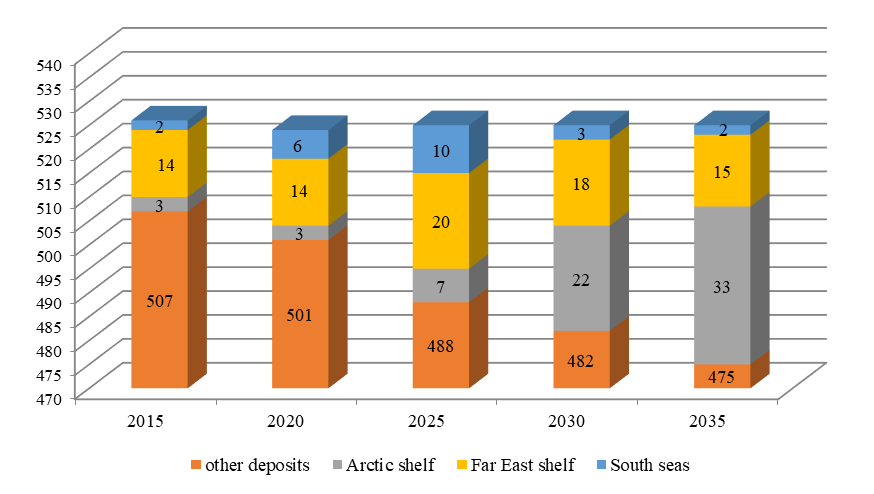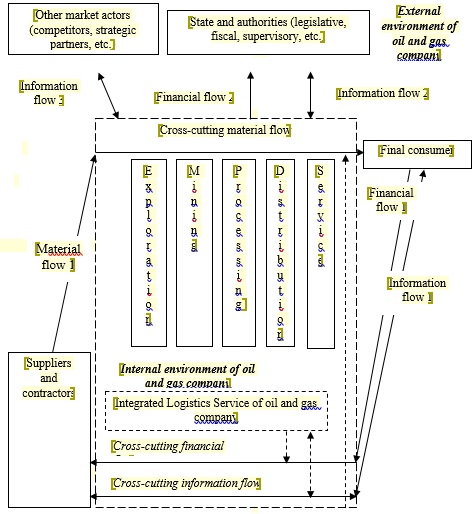Abstract
The oil and gas complex of the Russian Federation is a priority industry that provides a significant contribution to the country's economy. The largest share of Russian exports are oil and gas. The oil and gas complex of the Russian Federation provides the main revenues of foreign exchange earnings of our country. Thus, the development of this industry depends on world oil prices. Due to the fall in oil prices, the size of investments is reduced, which leads to the deterioration of fixed assets, the reduction of operated wells. In this regard, it is necessary to effectively manage costs by optimizing the accounting and control system. Thus, the Arctic zone of Russia is a huge potential for Russia's development. Logistics system in the oil and gas industry is an adaptive feedback system, within which certain logistics operations are performed, consisting of several elements of subsystems and having developed links with the external environment and strong, stable links between the elements of the system. The peculiarity of logistics systems at oil-producing enterprises is that a significant share of costs are the costs of exploration of a specific territory, processing and evaluation of the results obtained, drilling of appraisal wells, design work, construction of a shift camp and production infrastructure. As a result, industrial development of hydrocarbon deposits takes 15-20% of all costs, the cost of environmental measures-15%.
Keywords: Logistics coststransportationoil and gas industryArcticnational project
Introduction
The oil and gas complex of the Russian Federation is a priority industry providing a significant contribution to the economy of the country. The largest share of Russian exports is oil and gas. The oil and gas complex of the Russian Federation provides the main flow of foreign exchange revenues of our country. Thus, the development of this industry depends on world oil prices.
It should be noted that at present the theoretical approach to accounting for logistics costs in the oil companies of the Arctic zone has not yet been fully formed. Most studies on accounting for logistics costs are limited to identifying and classifying possible cost elements. Regarding the assessment of logistics costs in the Arctic, different points of view are found in the scientific literature. In particular, I would like to highlight the significant work in this area published recently by the following scientists (Ahmad, Rezaei, Tavasszy, & de Brito, 2016; Bahree, 2006; Chiung-Lin, & Pei-Yu, 2016; Giri, & Sarker, 2017; Göbl, & Froschmayer, 2011; Gu, & Dong, 2016; Jamali, Karam, Yin, & Soundararajan, 2017; Liu, Huo, Liu, & Zhao, 2015; Maley, 2015; Tjader, May, Shang, & Vargas, 2014; Wright, Forster, & Beale, 2017).
Problem Statement
Due to the fall in oil prices, the size of investments is decreasing, which leads to wear of fixed assets, reduction of operating wells. Therefore, it is necessary to manage costs effectively by optimizing the accounting and control system. The aim of the research is to study the features of accounting for logistics costs in organizations of the oil and gas industry in the Arctic zone.
Research Questions
The Arctic zone of the Russian Federation is more than 20% of the territory of Russia. Currently 95% of gas, 75% of oil, most of nickel, tin, platinum, gold and diamonds are produced in the Far North regions. One third of the Arctic Ocean is occupied by the shelf of Russia's Arctic seas. The huge reserves of natural resources (gas, oil, non-ferrous metals) are concentrated in the coastal zone and offshore of these seas. The oil and gas potential is estimated at more than 100 billion tons - 30% of the world's oil and gas reserves. Today, Russia is one of the three leaders in hydrocarbon production.
In the Arctic zone, the volume of gas production is 83% of all production. Oil production in the Arctic has reached 17.6% of the national total, and this figure is projected to reach 26% by 2035 (Figure

Source: authors.
Development of oil and gas fields in the Arctic is associated with high costs and a high level of risk. When developing Arctic oil and gas resources, companies face a number of problems related to the harsh climate and lack of infrastructure.
Purpose of the Study
A logistics system in the oil and gas industry is an adaptable feedback system within which some logistics operations are performed. The system consists of several elements of subsystems and has developed connections with the environment and strong, stable connections between elements of the system.
Research Methods
During the writing of the work, such research methods as factor and structural analysis, observation and study of the regulatory framework were used. Let 's highlight the main stages of the flow process movement in the oil and gas company and present them in Figure
Exploration, engineering and exploration works, field development;
Oil and gas production;
Oil and gas processing;
Transportation to the domestic and foreign market;
Services.
The feature of logistics systems of oil-producing enterprises is that the significant share of the costs are the costs of exploration of a specific territory, processing and evaluation of the obtained results, drilling of evaluation wells, design works, construction of a working camp and production infrastructure. As a result the industrial development of hydrocarbons fields occupies 15-20% of all expenses; costs of ecological actions are 15%.

Source: authors.
The process of oil and gas production includes the following stages: maintenance of reservoir pressure; products extraction from wells; oil and gas collection and transportation; complex preparation of oil; fish wastewater treatment; external oil and gas pumping.
The technology features of the oil and gas industry define the structure of cost items that can be classified into three groups:
Flow rates related to wells operation;
Oil and gas production costs;
Costs associated with processing, storage and transportation of oil and gas.
The territory of the Arctic zone of Russia is characterized by a harsh climate, the temperature reaches - 60 C, the average temperature is 30 C, and +3 C in summer. The Arctic is home to a variety of significant mineral resources and other natural resources, and its territory is home to economic and social facilities in limited areas. The Arctic zone of the Russian Federation is characterized by dispersion of settlement, remoteness and transport inaccessibility, extreme vulnerability and slow recovery of natural ecosystems, and a high proportion of the population of indigenous peoples of the North.
The development of hydrocarbon deposits in the Arctic zone is accompanied by severe climatic conditions, which come with additional logistical costs related to the exploration and development of deposits, as well as oil and gas production.
There is practically no transport infrastructure, including road and rail transport in the Arctic zone. Thus, the development of the Northern Sea Route is necessary. The Arctic transport system should include a complex of maritime and river fleet vehicles, aviation, pipeline, rail and road transport and coastal infrastructure providing transport activities in the Arctic zone.
Development of oil and gas fields in the Arctic is associated with high costs and a high level of risk. When developing Arctic oil and gas resources, companies face a number of problems related to the harsh climate and lack of infrastructure.
The Vankor cluster, which is being developed by LLC RN-Vankor, a subsidiary of NC Rosneft, is not only the Vankor field, since the opening of which 30 years have passed. Currently, the company is actively developing new fields - Tagulsk, Lodochnoe and Suzun.
All standards in the field of industrial safety and environmental protection are met during the construction of the Vankor Cluster field facilities. Permafrost interval during the construction of cluster platform base is covered by special thermal insulating waterproof layer. So, all structures, including the drilling rig and wells, are situated on a sandy "pillow." There is no environmental impact at the sites.
The key to the long history of Vankor and successful work was oil and gas reserves, which have been constantly growing. Here are a few figures: in 1991 the oil reserves of Vankor were estimated at 125 million tons, by 2009 they became 500. Today Vankor is the whole cluster of deposits and it is also an extensive program of geological exploration in the north of the region - in the Arctic zone.
Findings
Oil production costs are accounted for and calculated under the items presented in Table
There are no items in the costing items item, such as "material costs"; "returnable waste"; "reject losses". A feature of the process of the oil and gas industry is that there are no semi-finished products and work in progress. That is, all expenses are written off in full for the cost of finished products. All costs are distributed between oil and gas in the oil and gas industry. The specifics of oil and gas production technology make it necessary to use a simple costing method, the costs of production are taken into account for one shift. Oil wells are equipped with ground and underground equipment, the operation of which is expensive, so the cost accounting should be carried out separately on ground and underground equipment.
Conclusion
Based on the analysis of specific features of cost accounting in the oil and gas industry, we can identify following areas for improving the production efficiency and reducing costs:
Use of energy-saving equipment;
Modernization of the equipment;
Implementation of low-waste and non-waste technological processes;
Complex processing of raw materials;
Ecology-oriented development.
References
- Ahmad, W. N. K. W., Rezaei, J., Tavasszy, L. A., & de Brito, M. P. (2016). Commitment to and preparedness for sustainable supply chain management in the oil and gas industry. Journal of Environmental Management, 180, 202–213.
- Bahree, B. (2006). Investment by oil industry stalls. The Wall Street Journal, 8, A11.
- Chiung-Lin, L., & Pei-Yu, L. (2016). Impact of external integration capabilities of third-party logistics providers on their financial performance. The International Journal of Logistics Management, 2, 263-283.
- Giri, B., & Sarker, B. (2017). Improving performance by coordinating a supply chain with third party logistics outsourcing under production disruption. Computers & Industrial Engineering, 103, 168-177.
- Göbl, M., & Froschmayer, A. (2011). Logistik als erfolgspotenzial. The power of logistics. From strategy to logistics business plan. Wiesbaden: Gabler Publishing House.
- Gu, Y., & Dong, S. (2016). Logistics cost management from the supply chain perspective. Journal of Service Science and Management, 9(3), 229-232.
- Jamali, D., Karam, C., Yin, J., & Soundararajan, V. (2017). CSR logics in developing countries: Translation, adaptation and stalled development. Journal of World Business, 52(3), 343-359.
- Liu, C., Huo, B., Liu, S., & Zhao, X. (2015). Effect of information sharing and process coordination on logistics outsourcing. Industrial Management and Data Systems, 115, 41-63.
- Maley, A. (2015). Logistic costs in the accounting system: The problem of identification and registration. Retrieved from https://core.ac.uk/download/pdf/81664210.pdf Accessed: 12.12.2019.
- Tjader, Y., May, J. H., Shang, J., & Vargas, L. G. (2014). Firm-level outsourcing decision making: A balanced scorecard-based analytic network process model. International Journal of Production Economics, 147(C), 614-623.
- Wright, M., Forster, G., & Beale, J. (2017). Improving iSc performance through outsourcing—Considerations for using third party service providers to increase innovation, capacity and efficiency. Vaccine, 35, 2195-2197.
Copyright information

This work is licensed under a Creative Commons Attribution-NonCommercial-NoDerivatives 4.0 International License.
About this article
Publication Date
01 April 2020
Article Doi
eBook ISBN
978-1-80296-081-5
Publisher
European Publisher
Volume
82
Print ISBN (optional)
-
Edition Number
1st Edition
Pages
1-1004
Subjects
Business, innovation, management, management techniques, development studies
Cite this article as:
Gizatullina, O. M., & Tarasova, T. M. (2020). Features Of Accounting For Logistics Costs In Oil Companies In The Arctiс. In V. V. Mantulenko (Ed.), Problems of Enterprise Development: Theory and Practice, vol 82. European Proceedings of Social and Behavioural Sciences (pp. 537-544). European Publisher. https://doi.org/10.15405/epsbs.2020.04.69
